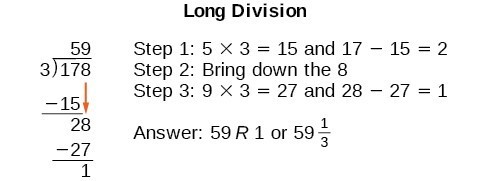Polynomial Long Division
Using Long Division to Divide Polynomials
We are familiar with the long division algorithm for ordinary arithmetic. We begin by dividing into the digits of the dividend that have the greatest place value. We divide, multiply, subtract, include the digit in the next place value position, and repeat.
For example, let’s divide [latex]178[/latex] by [latex]3[/latex] using long division.

Another way to look at the solution is as a sum of parts. This should look familiar, since it is the same method used to check division in elementary arithmetic.
[latex]\begin{array}{l}\left(\text{divisor }\cdot \text{ quotient}\right)\text{ + remainder}\text{ = dividend}\hfill \\ \left(3\cdot 59\right)+1 = 177+1 = 178\hfill \end{array}[/latex]
We call this the Division Algorithm and will discuss it more formally after looking at an another example.
Division of polynomials that contain more than one term has similarities to long division of whole numbers. We can write a polynomial dividend as the product of the divisor and the quotient added to the remainder. The terms of the polynomial division correspond to the digits (and place values) of the whole number division. This method allows us to divide two polynomials.
For example, if we were to divide [latex]2{x}^{3}-3{x}^{2}+4x+5[/latex] by [latex]x+2[/latex] using the long division algorithm, it would look like this:

We have found
[latex]\frac{2{x}^{3}-3{x}^{2}+4x+5}{x+2}=2{x}^{2}-7x+18-\frac{31}{x+2}[/latex]
or
[latex]2{x}^{3}-3{x}^{2}+4x+5=\left(x+2\right)\left(2{x}^{2}-7x+18\right)-31[/latex]
We can identify the dividend, divisor, quotient, and remainder.

Writing the result in this manner illustrates the Division Algorithm.
the division algorithm
The Division Algorithm states that given a polynomial dividend [latex]f\left(x\right)[/latex] and a non-zero polynomial divisor [latex]d\left(x\right)[/latex] where the degree of [latex]d\left(x\right)[/latex] is less than or equal to the degree of [latex]f\left(x\right)[/latex], there exist unique polynomials [latex]q\left(x\right)[/latex] and [latex]r\left(x\right)[/latex] such that
[latex]f\left(x\right)=d\left(x\right)q\left(x\right)+r\left(x\right)[/latex]
[latex]q\left(x\right)[/latex] is the quotient and [latex]r\left(x\right)[/latex] is the remainder. The remainder is either equal to zero or has degree strictly less than [latex]d\left(x\right)[/latex].
If [latex]r\left(x\right)=0[/latex], then [latex]d\left(x\right)[/latex] divides evenly into [latex]f\left(x\right)[/latex]. This means that both [latex]d\left(x\right)[/latex] and [latex]q\left(x\right)[/latex] are factors of [latex]f\left(x\right)[/latex].
- Set up the division problem.
- Determine the first term of the quotient by dividing the leading term of the dividend by the leading term of the divisor.
- Multiply the answer by the divisor and write it below the like terms of the dividend.
- Subtract the bottom binomial from the terms above it.
- Bring down the next term of the dividend.
- Repeat steps 2–5 until reaching the last term of the dividend.
- If the remainder is non-zero, express as a fraction using the divisor as the denominator.
Divide [latex]6{x}^{3}+11{x}^{2}-31x+15[/latex] by [latex]3x - 2[/latex].
Using Synthetic Division to Divide Polynomials
As we’ve seen, long division of polynomials can involve many steps and be quite cumbersome. Synthetic division is a shorthand method of dividing polynomials for the special case of dividing by a linear factor whose leading coefficient is [latex]1[/latex].
synthetic division
Synthetic division is a shortcut that can be used when the divisor is a binomial in the form [latex]x−k[/latex] where [latex]k[/latex] is a real number. In synthetic division, only the coefficients are used in the division process.
To illustrate the process, let’s look at an example.
Divide [latex]2x^3 - 3x^2 + 4x + 5[/latex] by [latex]x + 2[/latex] using the long division algorithm.
The final form of the process looked like this:

There is a lot of repetition in the table. If we don’t write the variables but, instead, line up their coefficients in columns under the division sign and also eliminate the partial products, we already have a simpler version of the entire problem.

Synthetic division carries this simplification even a few more steps. Collapse the table by moving each of the rows up to fill any vacant spots. Also, instead of dividing by [latex]2[/latex], as we would in division of whole numbers, then multiplying and subtracting the middle product, we change the sign of the “divisor” to [latex]–2[/latex], multiply and add. The process starts by bringing down the leading coefficient.

We then multiply it by the “divisor” and add, repeating this process column by column, until there are no entries left. The bottom row represents the coefficients of the quotient; the last entry of the bottom row is the remainder. In this case, the quotient is [latex]2x^2 - 7x + 18[/latex] and the remainder is [latex]-31[/latex].
- Write [latex]k[/latex] for the divisor.
- Write the coefficients of the dividend.
- Bring the lead coefficient down.
- Multiply the lead coefficient by [latex]k[/latex]. Write the product in the next column.
- Add the terms of the second column.
- Multiply the result by [latex]k[/latex]. Write the product in the next column.
- Repeat steps 5 and 6 for the remaining columns.
- Use the bottom numbers to write the quotient. The number in the last column is the remainder and has degree [latex]0[/latex], the next number from the right has degree [latex]1[/latex], the next number from the right has degree [latex]2[/latex], and so on.
Try an example on your own.


